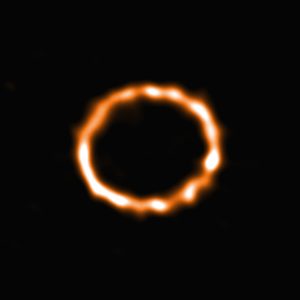Tabby’s Star, located 1,276 light years from Earth and named for its discoverer Tabetha S. Boyajian, created quite a buzz among astronomers when it was found in 2009 by the Kepler Space Observatory. It glowed a yellowish white and had temperature of around 10,000 degrees Fahrenheit!
However, scientists wondered why a star of that size and color was so much dimmer than they expected, and shining in a non-uniform way. Based on what we know about stars, the star itself should provide a constant source of light, rather than one that dramatically flickers.
The running hypothesis for a while was that an advanced civilization living near that star had built a complex solar panel structure around the star to better harness its energy, and thus obstructing the star’s starlight. This hypothesis was so seriously discussed that it motivated the SETI (Search for ExtraTerrestrial Intelligence) Institute to investigate the star for electromagnetic signs, like radio signals, but they found no evidence of deliberately produced electromagnetic signals.
Recently, Dr. Luboš Neslušan and Dr. Jan Budaj at the Astronomical Institute Slovak Academy of Sciences proposed a more likely explanation for the star’s strange behavior. When scientists are trying to understand something, they make comparisons with known phenomena. They found another star that flickered similarly to Tabby’s Star, and noticed that this star happened to be covered in an oddly shaped layer of dust. A star might be surrounded by dust if it happens to engulf one of its planets. The intense heat from the nuclear reactions in the star cause the planet to explode, fanning all the contents of the planet around the star in a dust cloud. It seemed plausible that this dust cloud could be causing the unexpected flickering pattern, rather than alien solar panels.
To test their hypothesis, the team ran a computer simulation of this star and its dust cloud. Scientists can use mathematical equations to represent star size, the gravity of the star, and many other characteristics and then solve the equation in multiple times to see what the results will be under different conditions. This computer simulation assumed the same kind, size, gravity, and shape as Tabby’s Star. The scientists tried three different scenarios for what would cause the strange dimming pattern, tracking the movement of the dust clouds around the star, to see which outcome most closely matched their real-life observations.

A ring of debris around an F star like Tabby’s Star, possibly from an exploding planet.
Scenario 1: They released all dust particles at the same time from a single point in space, such as a large volcanic eruption from a nearby planet.
Scenario 2: They released dust at different intervals around the star, representing a large number of eruptions from a nearby planet over a period of time.
Scenario 3 was a donut shape around the star, representing an exploding planet. (See the image to the left)
The results of the simulations were then compared to the observations that could be seen with a telescope. While the simulation could still use some improvement, Dr. Luboš Neslušan and Dr. Jan Budaj found that these simulations do represent the dust clouds well.
Next, the simulation was used to see any of the scenarios matched Tabby’s Star. When looking at the star initially, they found Scenario 1 to be a better match. However, when they looked at the star 800 days later, the Scenario 2 was a much better match. Then, at 1540 days, the Scenario 3 was a better representation. These differences are because the star and dust are rotating, so looking at different times mean you see different sides of the star.
This study tells us new things about the physics of dust clouds. Even if Tabby’s Star is not surrounded by alien technology, we have learned that dust clouds around stars in space behave in ways that are far more complex than we previously thought. While disappointing for SETI efforts, and far less glamorous for society than finding signs of an advanced alien civilization, the exploration of this outlandish idea enabled scientists to learn something new. If we understand more about how dust clouds behave around stars, we may be able to better explain other strange observations of stars in space.


